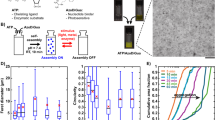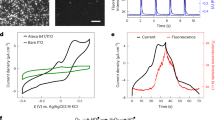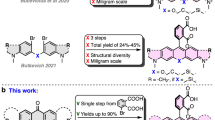Abstract
Organic fluorophores are the keystone of advanced biological imaging. The vast chemical space of fluorophores has been extensively explored in search of molecules with ideal properties. However, within the current molecular constraints, there appears to be a trade-off between high brightness, robust photostability, and tunable biochemical properties. Herein we report a general strategy to systematically boost the performance of donor-acceptor-type fluorophores, such as rhodamines, by leveraging SO2 and O-substituted azabicyclo[3.2.1] octane auxochromes. These bicyclic heterocycles give rise to a collection of ‘bridged’ dyes (BD) spanning the ultraviolet and visible range with top-notch quantum efficiencies, enhanced water solubility, and tunable cell-permeability. Notably, these azabicyclic fluorophores showed remarkable photostability compared to their tetramethyl or azetidine analogs while being completely resistant to oxidative photoblueing. Functionalized BD dyes are tailored for applications in single-molecule imaging, super-resolution imaging (STED and SIM) in fixed or live mammalian and plant cells, and live zebrafish imaging and chemogenetic voltage imaging.
This is a preview of subscription content, access via your institution
Access options
Access Nature and 54 other Nature Portfolio journals
Get Nature+, our best-value online-access subscription
$32.99 / 30 days
cancel any time
Subscribe to this journal
Receive 12 print issues and online access
$259.00 per year
only $21.58 per issue
Buy this article
- Purchase on SpringerLink
- Instant access to full article PDF
Prices may be subject to local taxes which are calculated during checkout





Similar content being viewed by others
Data availability
All data associated with this study are presented in the main text or Supplementary Information. The raw high-performance liquid chromatography, mass spectrometry, and nuclear magnetic resonance spectroscopy data are provided in the Supplementary Information. The structure of HaloTag7 bound to BD626HTL has been deposited in the Protein Data Bank (PDB 6Y7B).
The raw imaging data for Figures 4d, and 5c,f,h are provided as Supplementary Videos 1–4. All chemical probes reported in this work are available from the corresponding author upon reasonable request. Selected BDHTL dyes are commercially available from Genvivo Biotech and Spirochrome. Source data are provided with this paper.
References
Sahl, S. J., Hell, S. W. & Jakobs, S. Fluorescence nanoscopy in cell biology. Nat. Rev. Mol. Cell Biol. 18, 685–701 (2017).
Liu, Z., Lavis, LukeD. & Betzig, E. Imaging live-cell dynamics and structure at the single-molecule level. Mol. Cell. 58, 644–659 (2015).
Sigal, Y. M., Zhou, R. & Zhuang, X. Visualizing and discovering cellular structures with super-resolution microscopy. Science 361, 880–887 (2018).
Schermelleh, L. et al. Super-resolution microscopy demystified. Nat. Cell Biol. 21, 72–84 (2019).
Wang, L., Frei, M. S., Salim, A. & Johnsson, K. Small-molecule fluorescent probes for live-cell super-resolution microscopy. J. Am. Chem. Soc. 141, 2770–2781 (2018).
Schnermann, M. J. & Lavis, L. D. Rejuvenating old fluorophores with new chemistry. Curr. Opin. Chem. Biol. 75, 102335 (2023).
Samanta, S. et al. Xanthene, cyanine, oxazine and BODIPY: the four pillars of the fluorophore empire for super-resolution bioimaging. Chem. Soc. Rev. 52, 7197–7261 (2023).
Zhang, Y., Ling, J., Liu, T. & Chen, Z. Lumos maxima—how robust fluorophores resist photobleaching? Curr. Opin. Chem. Biol. 79, 102439 (2024).
Sletten, E. M. & Bertozzi, C. R. Bioorthogonal chemistry: fishing for selectivity in a sea of functionality. Angew. Chem. Int. Ed. 48, 6974–6998 (2009).
Koniev, O. & Wagner, A. Developments and recent advancements in the field of endogenous amino acid selective bond forming reactions for bioconjugation. Chem. Soc. Rev. 44, 5495–5551 (2015).
Xue, L., Karpenko, I. A., Hiblot, J. & Johnsson, K. Imaging and manipulating proteins in live cells through covalent labeling. Nat. Chem. Biol. 11, 917–923 (2015).
Saimi, D. & Chen, Z. Chemical tags and beyond: live‐cell protein labeling technologies for modern optical imaging. Smart Mol. 1, e20230002 (2023).
Giepmans, B. N. G., Adams, S. R., Ellisman, M. H. & Tsien, R. Y. The fluorescent toolbox for assessing protein location and function. Science 312, 217–224 (2006).
Rodriguez, E. A. et al. The growing and glowing toolbox of fluorescent and photoactive proteins. Trends Biochem. Sci. 42, 111–129 (2017).
Grimm, J. B. & Lavis, L. D. Caveat fluorophore: an insiders’ guide to small-molecule fluorescent labels. Nat. Methods 19, 149–158 (2021).
Panchuk–Voloshina, Nataliya et al. Alexa Dyes, a series of new fluorescent dyes that yield exceptionally bright, photostable conjugates. J. Histochem. Cytochem. 47, 1179–1188 (1999).
Grabowski, Z. R., Rotkiewicz, K. & Rettig, W. Structural changes accompanying intramolecular electron transfer: Focus on twisted intramolecular charge-transfer states and structures. Chem. Rev. 103, 3899–4031 (2003).
Wang, C. et al. Twisted intramolecular charge transfer (TICT) and twists beyond TICT: from mechanisms to rational designs of bright and sensitive fluorophores. Chem. Soc. Rev. 50, 12656–12678 (2021).
Song, X. Z., Johnson, A. & Foley, J. 7-Azabicyclo[2.2.1]heptane as a unique and effective dialkylamino auxochrome moiety: demonstration in a fluorescent rhodamine dye. J. Am. Chem. Soc. 130, 17652–17653 (2008).
Grimm, J. B. et al. A general method to improve fluorophores for live-cell and single-molecule microscopy. Nat. Methods 12, 244–250 (2015).
Grimm, J. B. et al. A general method to fine-tune fluorophores for live-cell and in vivo imaging. Nat. Methods 14, 987–994 (2017).
Grimm, J. B. et al. Optimized red-absorbing dyes for imaging and sensing. J. Am. Chem. Soc. 145, 23000–23013 (2023).
Los, G. V. et al. HaloTag: a novel protein labeling technology for cell imaging and protein analysis. ACS Chem. Biol. 3, 373–382 (2008).
Keppler, A. et al. A general method for the covalent labeling of fusion proteins with small molecules in vivo. Nat. Biotechnol. 21, 86–89 (2003).
Helmerich, D. A., Beliu, G., Matikonda, S. S., Schnermann, M. J. & Sauer, M. Photoblueing of organic dyes can cause artifacts in super-resolution microscopy. Nat. Methods 18, 253–257 (2021).
Dasgupta, A. et al. Effects and avoidance of photoconversion-induced artifacts in confocal and STED microscopy. Nat. Methods 21, 1171–1174 (2024).
Grimm, J. B. et al. A general method to improve fluorophores using deuterated auxochromes. JACS Au 1, 690–696 (2021).
Roßmann, K. et al. N-Methyl deuterated rhodamines for protein labelling in sensitive fluorescence microscopy. Chem. Sci. 13, 8605–8617 (2022).
Ye, Z. et al. Quaternary piperazine-substituted rhodamines with enhanced brightness for super-resolution imaging. J. Am. Chem. Soc. 141, 14491–14495 (2019).
Lv, X., Gao, C., Han, T., Shi, H. & Guo, W. Improving the quantum yields of fluorophores by inhibiting twisted intramolecular charge transfer using electron-withdrawing group-functionalized piperidine auxochromes. Chem. Commun. 56, 715–718 (2020).
Butkevich, A. N., Bossi, M. L., Lukinavičius, G. & Hell, S. W. Triarylmethane fluorophores resistant to oxidative photobluing. J. Am. Chem. Soc. 141, 981–989 (2018).
Wang, L. G. et al. OregonFluor enables quantitative intracellular paired agent imaging to assess drug target availability in live cells and tissues. Nat. Chem. 15, 729–739 (2023).
Corrie, J. E. T. & Munasinghe, V. R. N. Substituent effects on the apparent pK of the reversible open-to-closed transition of sultams derived from sulforhodamine dyes. Dyes Pigm. 79, 76–82 (2008).
Grimm, J. B. & Lavis, L. D. Synthesis of rhodamines from fluoresceins using Pd-catalyzed C-N cross-coupling. Org. Lett. 13, 6354–6357 (2011).
Zhang, J. et al. Red- and far-red-emitting zinc probes with minimal phototoxicity for multiplexed recording of orchestrated insulin secretion. Angew. Chem. Int. Ed. 60, 25846–25855 (2021).
Walker, D. & Rogier, D. Preparation of novel bridged bicyclic thiomorpholines as potentially useful building blocks in medicinal chemistry. Synthesis 45, 2966–2970 (2013).
Köbrich, G. Bredt compounds and the Bredt rule. Angew. Chem. Int. Ed. 12, 464–473 (2003).
Wang, C. et al. Quantitative design of bright fluorophores and AIEgens by the accurate prediction of twisted intramolecular charge transfer (TICT). Angew. Chem. Int. Ed. 59, 10160–10172 (2020).
Wang, B., Chai, X., Zhu, W., Wang, T. & Wu, Q. A general approach to spirolactonized Si-rhodamines. Chem. Commun. 50, 14374–14377 (2014).
Kim, D.-H. et al. Blue-conversion of organic dyes produces artifacts in multicolor fluorescence imaging. Chem. Sci. 12, 8660–8667 (2021).
Mujumdar, R. B., Ernst, L. A., Mujumdar, S. R., Lewis, C. J. & Waggoner, A. S. Cyanine dye labeling reagents - sulfoindocyanine succinimidyl esters. Bioconjugate Chem. 4, 105–111 (1993).
Wurm, C. A. et al. Novel red fluorophores with superior performance in STED microscopy. Opt. Nanoscopy 1, 1–7 (2012).
Lukinavičius, G. et al. A near-infrared fluorophore for live-cell super-resolution microscopy of cellular proteins. Nat. Chem. 5, 132–139 (2013).
Butkevich, A. N. et al. Fluorescent rhodamines and fluorogenic carbopyronines for super‐resolution STED microscopy in living cells. Angew. Chem. Int. Ed. 55, 3290–3294 (2016).
Wilhelm, J. et al. Kinetic and structural characterization of the self-labeling protein tags HaloTag7, SNAP-tag, and CLIP-tag. Biochemistry 60, 2560–2575 (2021).
Abdelfattah, A. S. et al. Bright and photostable chemigenetic indicators for extended in vivo voltage imaging. Science 365, 699–704 (2019).
Huppertz, M.-C. et al. Recording physiological history of cells with chemical labeling. Science 383, 890–897 (2024).
Tokunaga, M., Imamoto, N. & Sakata-Sogawa, K. Highly inclined thin illumination enables clear single-molecule imaging in cells. Nat. Methods 5, 159–161 (2008).
Abdelfattah, A. S. et al. Sensitivity optimization of a rhodopsin-based fluorescent voltage indicator. Neuron 111, 1547–1563 (2023).
Napier, R. M., Fowke, L. C., Hawes, C., Lewis, M. & Pelham, H. R. Immunological evidence that plants use both HDEL and KDEL for targeting proteins to the endoplasmic reticulum. J. Cell Sci. 102, 261–271 (1992).
Denecke, J., De Rycke, R. & Botterman, J. Plant and mammalian sorting signals for protein retention in the endoplasmic reticulum contain a conserved epitope. EMBO J. 11, 2345–2355 (1992).
Lv, X. et al. Membrane microdomains and the cytoskeleton constrain AtHIR1 dynamics and facilitate the formation of an AtHIR1‐associated immune complex. Plant J. 90, 3–16 (2017).
Hara, D. et al. Silinanyl rhodamines and silinanyl fluoresceins for super-resolution microscopy. J. Phys. Chem. B 125, 8703–8711 (2021).
Lu, X. et al. Super-photostability and super-brightness of EC5 dyes for super-resolution microscopy in the deep near-infrared spectral region. Chem. Mater. 36, 949–958 (2024).
Grimm, J. B. et al. A general method to optimize and functionalize red-shifted rhodamine dyes. Nat. Methods 17, 815–821 (2020).
Wang, L. et al. A general strategy to develop cell permeable and fluorogenic probes for multicolour nanoscopy. Nat. Chem. 12, 165–172 (2019).
Liu, T. et al. Gentle rhodamines for live-cell fluorescence microscopy. ACS Cent. Sci. 10, 1933–1944 (2024).
Grimm, J. et al. A general method to fine-tune fluorophores for live-cell and in vivo imaging. Nat. Methods 14, 987–994 (2017).
Adamo, C. & Baorne, V. Toward. Reliable density functional methods without adjustable parameters: the PBE0 model. J. Chem. Phys. 110, 6158–6170 (1999).
Stephens, P. J. et al. Ab initio calculation of vibrational absorption and circular dichroism spectra using density functional force fields. J. Phys. Chem. 98, 11623–11627 (1994).
Grimme, S., Antony, J., Ehrlich, S. & Krieg, H. A consistent and accurate ab initio parametrization of density functional dispersion correction (DFT-D) for the 94 elements H-Pu. J. Chem. Phys. 132, 154104 (2010).
Krishnan, R. et al. Self‐consistent molecular orbital methods. XX. A basis set for correlated wave functions. J. Chem. Phys. 72, 650–654 (1980).
Clark, T., Chandrasekhar, J., Spitznagel, G. W. & Schleyer, P. V. R. Efficient diffuse function-augmented basis sets for anion calculations. III. The 3-21+G basis set for first-row elements, Li–F. J. Comput. Chem. 4, 294–301 (1983).
Marenich, A. V., Cramer, C. J. & Truhlar, D. G. Universal solvation model based on solute electron density and on a continuum model of the solvent defined by the bulk dielectric constant and atomic surface tensions. J. Phys. Chem. B 113, 6378 (2009).
McCoy, A. J. et al. Phaser crystallographic software. J. Appl. Crystallogr. 40, 658–674 (2007).
Lebedev, A. A. et al. JLigand: a graphical tool for the CCP4 template-restraint library. Acta Crystallogr. D 68, 431–440 (2012).
Winn, M. D. et al. Overview of the CCP4 suite and current developments. Acta Crystallogr. D 67, 235–242 (2011).
Emsley, P. & Cowtan, K. Coot: model-building tools for molecular graphics. Acta Crystallogr. D 60, 2126–2132 (2004).
Emsley, P., Lohkamp, B., Scott, W. G., & Cowtan, K. Features and development of Coot. Acta Crystallogr. D 66, 486–501 (2010).
Afonine, P. V. et al. Towards automated crystallographic structure refinement with phenix.refine. Acta Crystallogr. D 68, 352–367 (2012).
Chen, V. B. et al. MolProbity: all-atom structure validation for macromolecular crystallography. Acta Crystallogr. D 66, 12–21 (2010).
Adams, P. D. et al. PHENIX: a comprehensive Python-based system for macromolecular structure solution. Acta Crystallogr. D 66, 213–221 (2010).
Hansen, A. S., Pustova, I., Cattoglio, C., Tjian, R. & Darzacq, X. CTCF and cohesin regulate chromatin loop stability with distinct dynamics. eLife 6, e25776 (2017).
Sergé, A., Bertaux, N., Rigneault, H. & Marguet, D. Dynamic multiple-target tracing to probe spatiotemporal cartography of cell membranes. Nat. Methods 5, 687–694 (2008).
Clough, S. J. in Transgenic Plants: Methods and Protocols. Methods in Molecular Biology Vol. 286 (ed. Peña, L.) 91–101 (Humana Press, 2005).
Lang, C., Schulze, J., Mendel, R.-R. & Hänsch, R. HaloTag™: a new versatile reporter gene system in plant cells. J. Exp. Bot. 57, 2985–2992 (2006).
Acknowledgements
This project was supported by funds from National Key R&D Program of China (2021YFF0502904 to Z.C.; 2020YFA0509502 to W.D.), the Beijing Municipal Science & Technology Commission (project Z221100003422013 to Z.C.), the Beijing National Laboratory for Molecular Sciences (BNLMS202407 to Z.C.), and the Natural Science Foundation of China (32170566 to W.D.). We thank L. Chen at Peking University for the guidance in analyzing crystal structures. We thank J. Lin for the assistance with plant-cell imaging. We thank P. Xi for assistance with SIM imaging. We thank the Tsinghua University Branch of China National Center for Protein Sciences (Beijing) and Tsinghua University Technology Center for Protein Research for the X-ray crystallography facility support. We thank S. Fan, L. Wang, and M. Li at the X-ray crystallography platform of National Protein Science Facility, Tsinghua University, Beijing, for their technical help. We thank the Metabolic Mass Spectrometry Platform at the IMM, the analytical instrumentation center of Peking University, the NMR facility of the National Center for Protein Sciences at Peking University, and the National Center for Protein Sciences at Peking University.
Author information
Authors and Affiliations
Contributions
Z.C. conceived the study. J.Z. and P.C. performed the chemical synthesis and characterizations. J.Z. performed the photophysical tests. K.Z. solved the crystal structures of HaloTag7–BD626. J.Z., M.Z., and T.L. performed confocal and STED imaging. K.W., S.F., and X.Z. performed in vivo imaging. B.W. performed single-molecule imaging. S.Z. performed voltage imaging. H.Q. performed SIM imaging on plant cells. Y.M. performed chemical calculations. Y.S. performed photo-crosslinking experiments. Y.F. performed SIM imaging on mammalian cells. P.Z., W.D., Y.M., and Z. C. supervised the project. J.Z. and Z.C. wrote the paper.
Corresponding author
Ethics declarations
Competing interests
Z.C., J.Z., and P. C. are the inventors of a patent on the bridged-bicycle strengthened fluorophores (CN2023108090626, patent pending), whose value could be affected by this paper. The other authors declare no competing interests.
Peer review
Peer review information
Nature Methods thanks Lei Wang, Youjun Yang and the other, anonymous, reviewer(s) for their contribution to the peer review of this work. Primary Handling Editor: Rita Strack, in collaboration with the Nature Methods team.
Additional information
Publisher’s note Springer Nature remains neutral with regard to jurisdictional claims in published maps and institutional affiliations.
Extended data
Extended Data Fig. 1 A crystal structure of BD626HTL at the HaloTag7 shows additional interactions between dye and protein.
(a)Structural comparison between HT7-CPY (cyan, PDB 6Y7B) and HT7-BD626 (yellow, PDB 9JHA); (b-c) Close-ups of the substrate binding sites. Proteins are represented as pink or gray cartoons. Fluorophores and residues are shown as sticks. A polar interaction is identified between the bridged auxochrome and Q165 and shown as dashed lines with annotated distances; (d)A overlaid comparison of CPYHTL and BD626HTL in the pocket of HT7.
Extended Data Fig. 2 BD566HTL enables time-lapse SIM imaging.
(a)Time-lapse SIM images of live COS-7 cells stably expressing TOMM20-HT7 labeled with BD566HTL (500 nM, 1 h, 37 °C, one wash), scale bar=2 μm; (b) Normalized fluorescence decay curves of samples in (a), n = 4 in 2 independent experiments; error bar show ± s.d.
Extended Data Fig. 3 BD626HTL can offer 25 z-frames for 3D reconstruction, enabling the construction of the distribution of the cytoskeleton (Cep41) throughout the entire cell.
Orthogonal views of 3D-STED images of fixed HeLa cells expressing Cpe41-HT7 labeled with BD626HTL (500 nM, 30 min, 37 °C, one wash). An area of 52.5 × 51.0 μm (x–y) was recorded in 65 nm z-stacks over 25 times; scale bar= 1 μm.
Supplementary information
Supplementary Information
Supplementary Figures 1–12, Supplementary Tables 1 and 2, Supplementary Schemes 1–3, Synthesis and characterization of new compounds, NMR spectra, and Supplementary References.
Supplementary Video 1
Time-lapse single-molecule images of fixed U-2 OS cells stably expressing H2B-HaloTag7 labeled with TMRHTL, JF549HTL and BD566HTL; scale bar, 5 μm.
Supplementary Video 2
Time-lapse STED images of live HeLa cells expressing TOMM20-HaloTag7 labeled with BD626HTL, SiRHTL or JF646HTL; scale bar, 1 μm.
Supplementary Video 3
Time-lapse TIRF-SIM images of live Arabidopsis thalianas cells expressing HIR1-HaloTag7 labeled with BD626HTL or JF646HTL; scale bar, 1 μm.
Supplementary Video 4
Z-stack confocal images and 3D reconstruction of a live zebrafish expressing elavl3:H2B-HT7 and labeled with BD566HTL.
Source data
Source Data Fig. 2
Statistical source data.
Source Data Fig. 2
Unprocessed gels.
Source Data Fig. 3
Statistical source data.
Source Data Fig. 4
Statistical source data.
Source Data Fig. 5
Statistical source data.
Rights and permissions
Springer Nature or its licensor (e.g. a society or other partner) holds exclusive rights to this article under a publishing agreement with the author(s) or other rightsholder(s); author self-archiving of the accepted manuscript version of this article is solely governed by the terms of such publishing agreement and applicable law.
About this article
Cite this article
Zhang, J., Zhang, K., Wang, K. et al. A palette of bridged bicycle-strengthened fluorophores. Nat Methods 22, 1276–1287 (2025). https://doi.org/10.1038/s41592-025-02693-4
Received:
Accepted:
Published:
Issue date:
DOI: https://doi.org/10.1038/s41592-025-02693-4
This article is cited by
-
Bridge to a brighter future in fluorescence imaging
Nature Methods (2025)



